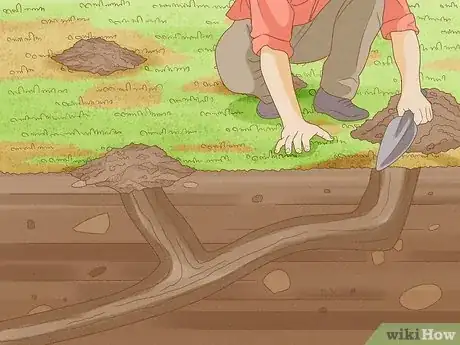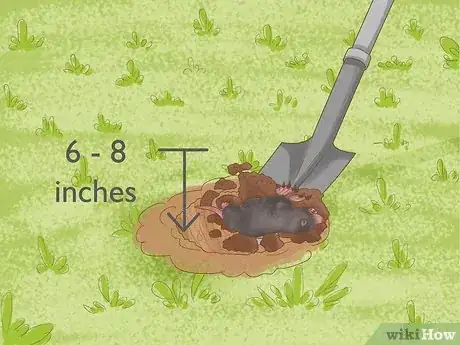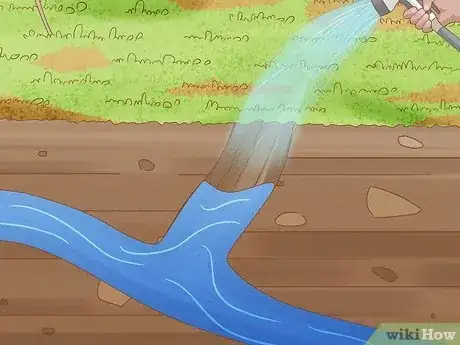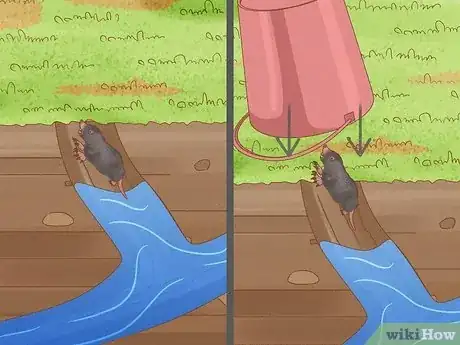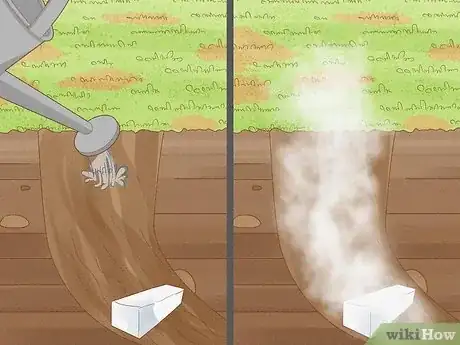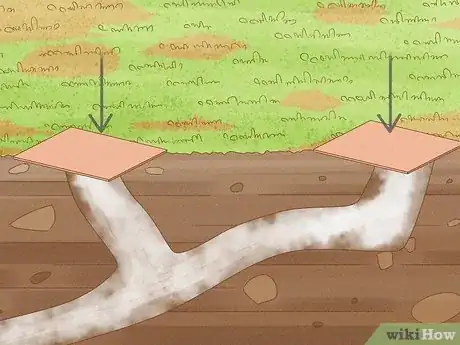This article was co-authored by Anthony "TC" Williams. Anthony "TC" Williams is a Professional Landscaper in Idaho. He is the President and Founder of Aqua Conservation Landscape & Irrigation, an Idaho Registered Landscape Business Entity. With over 21 years of landscaping experience, TC has worked on projects such as the Idaho Botanical Garden in Boise, Idaho. He is a Idaho Registered Contractor and a previously Licensed Irrigator in the State of Texas.
There are 8 references cited in this article, which can be found at the bottom of the page.
This article has been viewed 273,006 times.
Moles are carnivorous mammals that primarily live underground. They can grow to 7 inches (18 cm) in length and weigh up to 4 pounds (1.8 kg). Because moles eat soil pests like grubs and billbugs, increased mole activity indicates a high number of pests in the soil. Due to a mole's habit of digging into lawns to create mole hills and disrupting plant life in search of food, they are often considered pests. Fortunately, there are several ways to catch and/or get rid of them.
Steps
Setting a Trap
-
1Find mole tunnels. Look for a molehill.[1] A molehill will be indicated by fresh piles of dirt around your property. Tunnels will lead away from the molehill, so feel for grass areas extending away from the molehill that are softer to the touch or step. Moles like to dig their tunnels along structures like fences or other barriers, so look around any such structures in your yard to find their tunnels.
-
2Determine if the tunnel is active. Step on top of the tunnel to collapse it in one section on both sides. Dirt should be covering the tunnel way. Leave the collapsed tunnel for a day and then check to see if the collapsed dirt has been dug out again.[2] If it has, you know that that tunnel is active.Advertisement
-
3Expose a section of a tunnel. Use a gardening tool to carve out a section of the tunnel. Before you place the trap in the exposed section, pack down the dirt at the bottom of the tunnel so the mole can't dig underneath the trap. You should also loosely cover the tunnel back up with dirt, so the mole will continue to dig through the loose dirt, and get captured by the trap.[3]
-
4Set a trap. There are many kinds of mole catching traps out there. Most of the traps vary in the way they capture the mole, but nearly all are lethal. There are scissor jaw traps, harpoon traps, and choker loop traps just to name a few.[4] Read the trap instructions very carefully to figure out the best way to set the device. Change the settings on your chosen trap to make the trigger apparatus really sensitive. Once you know how to open and set the trap, place the trap into the cut out section of tunnel.
- For a scissor trap, place the jaws around loosely packed dirt in the middle of the tunnel. Leave the area between the jaws open and clear. The jaws should span across the runway of the tunnel and be pushed into the ground about 1 inch (2.5 cm) down.[5] Cock the trap according to the included instructions.
- For a harpoon trap, set and straddle the trap over the runway of the mole tunnel with both legs of the trap pushed down into the ground on each side of the tunnel.[6] Gently push the legs of the trap into the ground, positioning the trigger pan (the square, flat piece of metal) just above the soil.[7] Pull up the setting tee to set the trap.
- For a choker loop trap, use a garden tool to dig a hole into the tunnel from the top. Dig the hole a tad deeper than the actual depth of the tunnel, but the same width as the tunnel.[8] Place the loop into the tunnel so it follows the exact direction and angle of the tunnel. Pack the open area of the trap (in front of the loop) firmly with soil, so the mole will continue to dig through the tunnel and get caught in the trap.[9]
-
5Cover the trap. Cover the trap with some sort of large bucket to protect children and pets from coming near the area.[10] The bucket will also help block out any light which will let the mole continue digging.
-
6Remove the trap. Check on the trap every day to see if you have caught a mole. When the trap has finally been set off and has caught the mole, remove the trap and mole.[11] If you have not caught a mole after two days, try moving your trap to a new area.[12]
- There are many reasons a trap can fail (changed burrowing habits, too much tunnel disturbance, improperly set trap), but you will have to find out through trial and error, and consider setting your trap in a new location.[13]
-
7Dispose of the mole. Grab the mole with a plastic bag around you hand. Turn the bag inside out as you continue to hold onto the mole, and let the mole fall into the inside of the bag.[14] Tie the bag to seal it, and place the mole in with your garbage.
Digging up the Mole
-
1Find a new tunnel or mound. A new tunnel or mound will most likely have a mole digging through rather frequently. You can spot newer mounds by finding fresh, piles of dirt on your property. Consequently, tunnels will lead away from the mound, so feel for softer grass areas extending away from the mound. Check on the tunnel or mound frequently during the early morning or evening to see if you notice any movement just underneath the surface of the soil.[15]
- Moles tend to do most of their digging during the early morning and evening, so this is the best time to look out for them.
-
2Approach the tunnel or mound. Wait and watch the tunnel or mound to see movement as the mole digs through. When you see movements, approach the tunnel or mound very slowly so as not to alert the mole.[16]
- Be sure you are wearing protective gloves before attempting this method. You will have to handle the mole with your hands, and don't want the mole to bite you.
-
3Spade the mole out of the ground. Strike a spade or shovel deep into the ground (about 6 to 8 inches or 15 to 20 centimeters deep) behind the mole.[17] [18] Striking the spade or shovel behind the mole will prevent it from escaping as you try to remove them from the ground. When you have successfully spaded the mole out of the ground, quickly grab the mole with your hands and place it in a bucket for disposal later. Do not let the mole burrow it's way back into the ground after you have spaded it from the dirt.
-
4Contact animal services. Contact your local animal services agency for advice and instruction on where and how to release your captured moles. As mentioned before, there may be property restrictions along with humane and ethical disposal restrictions that can play a factor in the manner of disposing the moles.
Flooding the Mole Tunnels
-
1Find the active molehill. Fresh piles of dirt on the side of the mound will indicate an active molehill. The opening in the mound will be the mouth to the tunnels that you flood with water. When you flood the tunnels, dirt will wash back through the tunnels and drive out the moles.[21]
-
2Flood water into the molehill. Place the tip of your hose into the molehill mouth, and turn on the water. You don't want the water to run too fast, because you don't want the tunnels to fill up with water too quickly. You want to trick the mole into thinking that it is going to be flooded out of its tunnels, and have it escape some other way.[22]
-
3Have a bucket ready to catch any escaping moles. You will have to be ready at other nearby molehills to grab the moles as they try to escape, and place them in a bucket for later disposal. A bucket provides a safe area to contain the mole and ensure that it doesn't escape and dig back into your lawn.[23]
- Be sure to wear protective gloves when handling moles; their sharp teeth can pierce through skin.
-
4Contact animal services. Contact your local animal services agency for advice on where to release the moles you catch. You may be restricted in where you can dispose the mole, and the condition in which you are disposing the mole, so it's best to receive specific instructions from nearby animal services.
Catching Moles Alive
-
1Set a bucket under a tunnel. You can spot a molehill by finding fresh piles of dirt around your property. The tunnels will extend out from the molehill, so feel around the grassy area surrounding the molehill for spots that are softer to the touch or step. When you find a path of a tunnel, dig a deep hole going through, and underneath the tunnel.[24] Dig deep enough under the tunnel to place a 2 to 5 gallon (7.6 to 19 liter) bucket under the tunnel runway.[25]
-
2Cave in the sides of the tunnel way. Pack soil around the bucket, and block the mole runways on each side of the bucket.[26] This will cause the mole to continue digging and fall into the bucket as they break through the packed dirt.
-
3Cover the dug out hole. Cover the top of the dug out portion of the tunnel with sod or a large board to prevent sunlight from shining through to the tunnel.[27] [28] This will give the mole the sense that he is still digging underground even though the top of the tunnel has been disturbed and dug up.
-
4Catch the mole in the bucket. Remove the plywood or sod and check the hole every day to see if the mole has fallen into the bucket. If the mole has fallen into the bucket, you have successfully caught the mole.[29]
-
5Contact animal services. Contact your local animal services agency for advice on where to release the moles you catch. You may be able to release the moles in a forested area far from your property, but there may be lawful restraints on relocating a pest to another's property without permission. It may also be inhumane to release a mole that has experienced severe stress from being captured alive, especially if the mole has a low chance of survival upon being released.
- When in doubt, contact local animal services, and they will likely have the best disposal alternative.
Fumigating Mole Tunnels
-
1Place dry ice in several places along the tunnel network. Put small chunks or pellets of dry ice in various locations of the tunnel network. You should place a piece of dry ice in every molehill or tunnel opening to ensure that the entire tunnel will be fumigated when you add the water.[30]
- Always wear gloves when handling dry ice.
-
2Add a small amount of water to each piece of dry ice. Stick the hose into the molehill or tunnel network and spray a small amount of water on each piece of dry ice. This creates carbon dioxide gas which will effectively kill the moles.[31]
-
3Cover every opening to the tunnel. After adding the dry ice and water, you need to seal the openings. Pack dirt into each opening of the tunnel network to ensure that the moles will not be able to escape from the tunnel.[32]
Expert Q&A
Did you know you can get expert answers for this article?
Unlock expert answers by supporting wikiHow
-
QuestionDo moles hibernate?
 Anthony "TC" WilliamsAnthony "TC" Williams is a Professional Landscaper in Idaho. He is the President and Founder of Aqua Conservation Landscape & Irrigation, an Idaho Registered Landscape Business Entity. With over 21 years of landscaping experience, TC has worked on projects such as the Idaho Botanical Garden in Boise, Idaho. He is a Idaho Registered Contractor and a previously Licensed Irrigator in the State of Texas.
Anthony "TC" WilliamsAnthony "TC" Williams is a Professional Landscaper in Idaho. He is the President and Founder of Aqua Conservation Landscape & Irrigation, an Idaho Registered Landscape Business Entity. With over 21 years of landscaping experience, TC has worked on projects such as the Idaho Botanical Garden in Boise, Idaho. He is a Idaho Registered Contractor and a previously Licensed Irrigator in the State of Texas.
Experienced Landscaper
-
QuestionWill a mole dig in the yard year-round?
 Anthony "TC" WilliamsAnthony "TC" Williams is a Professional Landscaper in Idaho. He is the President and Founder of Aqua Conservation Landscape & Irrigation, an Idaho Registered Landscape Business Entity. With over 21 years of landscaping experience, TC has worked on projects such as the Idaho Botanical Garden in Boise, Idaho. He is a Idaho Registered Contractor and a previously Licensed Irrigator in the State of Texas.
Anthony "TC" WilliamsAnthony "TC" Williams is a Professional Landscaper in Idaho. He is the President and Founder of Aqua Conservation Landscape & Irrigation, an Idaho Registered Landscape Business Entity. With over 21 years of landscaping experience, TC has worked on projects such as the Idaho Botanical Garden in Boise, Idaho. He is a Idaho Registered Contractor and a previously Licensed Irrigator in the State of Texas.
Experienced Landscaper
-
QuestionHow could I entice a mole to come out of its hole?
 Community AnswerThey shun the light, so they won't come out in the daytime for pretty much anything. If you're patient though, you'll be able to see them come out at night, although there isn't really anything you could use to bring them out yourself.
Community AnswerThey shun the light, so they won't come out in the daytime for pretty much anything. If you're patient though, you'll be able to see them come out at night, although there isn't really anything you could use to bring them out yourself.
Warnings
- Always read and follow closely the instructions that come with traps. Both harpoon and scissor traps can cause serious injury if used incorrectly.⧼thumbs_response⧽
- Always use gloves when handling a live or dead mole.⧼thumbs_response⧽
References
- ↑ http://www.familyhandyman.com/pest-control/how-to-trap-moles/view-all
- ↑ http://www.familyhandyman.com/pest-control/how-to-trap-moles/view-all
- ↑ https://extension2.missouri.edu/g9440
- ↑ https://extension2.missouri.edu/g9440
- ↑ https://extension2.missouri.edu/g9440
- ↑ https://extension2.missouri.edu/g9440
- ↑ https://extension2.missouri.edu/g9440
- ↑ https://extension2.missouri.edu/g9440
- ↑ https://extension2.missouri.edu/g9440
- ↑ http://www.familyhandyman.com/pest-control/how-to-trap-moles/view-all
- ↑ http://www.familyhandyman.com/pest-control/how-to-trap-moles/view-all
- ↑ https://extension2.missouri.edu/g9440
- ↑ https://extension2.missouri.edu/g9440
- ↑ http://wdfw.wa.gov/living/moles.html
- ↑ https://extension2.missouri.edu/g9440
- ↑ https://extension2.missouri.edu/g9440
- ↑ https://www.youtube.com/watch?v=chHfOW5CS6U
- ↑ http://www.itsnotworkitsgardening.com/2011/05/how-i-catch-moles.html
- ↑ http://www.itsnotworkitsgardening.com/2011/05/how-i-catch-moles.html
- ↑ http://www.itsnotworkitsgardening.com/2011/05/how-i-catch-moles.html
- ↑ http://www.itsnotworkitsgardening.com/2011/05/how-i-catch-moles.html
- ↑ http://www.itsnotworkitsgardening.com/2011/05/how-i-catch-moles.html
- ↑ http://www.itsnotworkitsgardening.com/2011/05/how-i-catch-moles.html
- ↑ http://www.familyhandyman.com/pest-control/how-to-trap-moles/view-all
- ↑ http://www.familyhandyman.com/pest-control/how-to-trap-moles/view-all
- ↑ https://extension2.missouri.edu/g9440
- ↑ https://extension2.missouri.edu/g9440
- ↑ http://www.familyhandyman.com/pest-control/how-to-trap-moles/view-all
- ↑ http://www.familyhandyman.com/pest-control/how-to-trap-moles/view-all
- ↑ https://www.continentalcarbonic.com/blog/use-dry-ice-free-lawn-moles-gophers/
- ↑ https://www.continentalcarbonic.com/blog/use-dry-ice-free-lawn-moles-gophers/
- ↑ https://www.continentalcarbonic.com/blog/use-dry-ice-free-lawn-moles-gophers/
About This Article
If you need to catch a mole without killing it, look for a fresh pile of dirt somewhere on your property. These molehills are found at the entrance to their tunnels. Lightly press down with your foot around the hill to find the direction of the tunnel, then dig a deep hole going through and underneath the tunnel. Place a 2-5 gallon bucket under the tunnel runway, then pack soil around the bucket and cave in the tunnel on each side of the bucket. The mole will dig through the dirt and fall into the bucket. Read on for tips from our reviewer on how to catch moles by flooding a mole tunnel!


